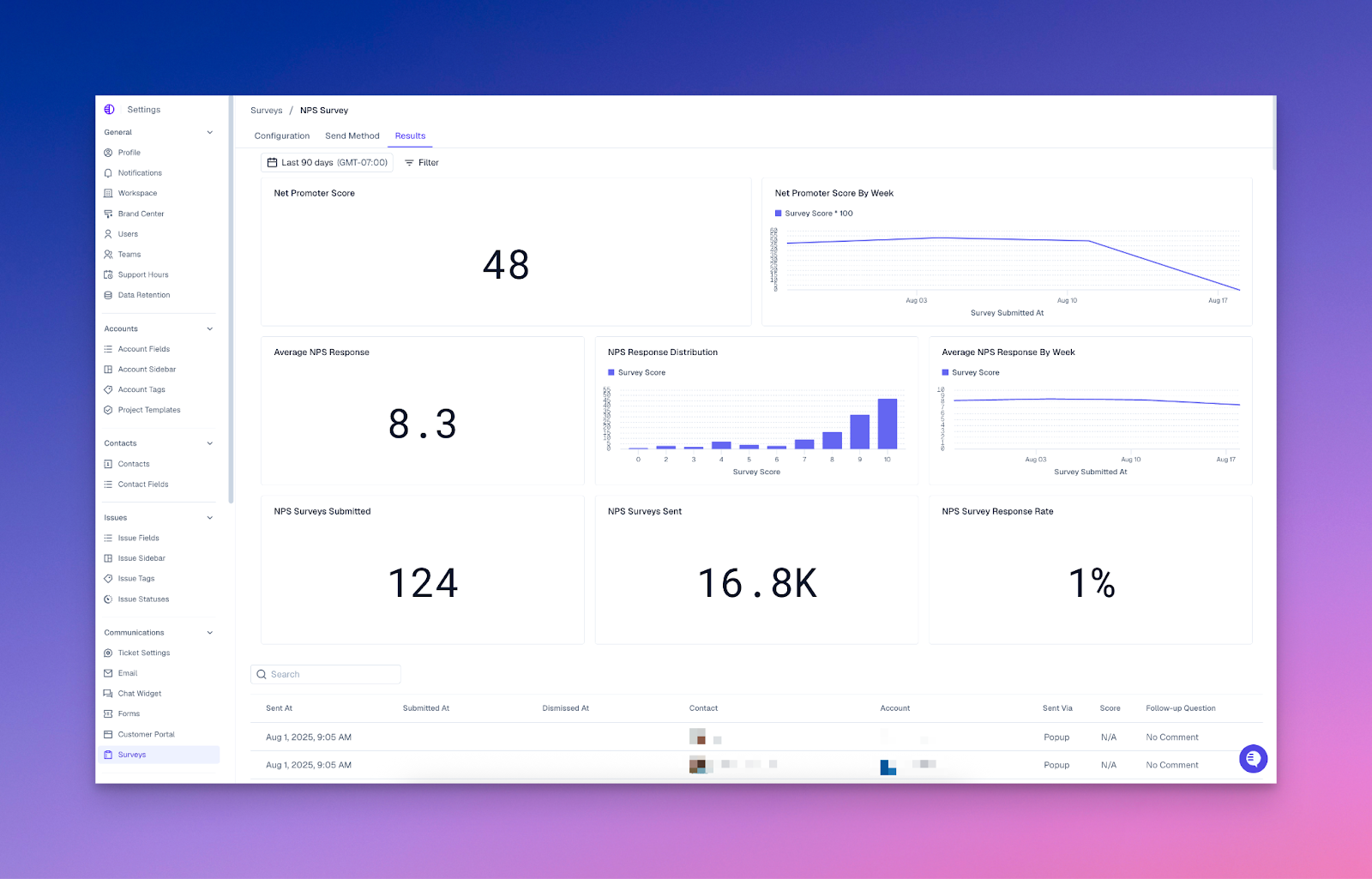Customer Feedback Surveys That Gather Actionable Insights
Find out how to create customer feedback surveys that provide valuable insights. Learn what questions to ask and which formats are most effective.
Your customers hold the most valuable information about your business. They know what they’re happy with and what they don’t like. And while you can make some guesses about what they think based on their actions, conversion and retention metrics don’t tell the whole story.
That’s why you need to actually ask buyers for their opinions. Customer feedback surveys are a perfect way to do that. They capture user perceptions in measurable ways, providing valuable insights into their experiences with your support team. You can then transform what you learn into effective B2B customer support strategies.
Let’s explore what customer satisfaction surveys look like and how you can create your own. We’ll also talk about the key metrics you should focus on, and introduce some best practices for analyzing the survey’s results.
What’s a Customer Satisfaction Survey?
Customers rarely explain what worked and what didn’t during an experience with your product or support team. Surveys for customers open the door, giving them a simple way to share how the interaction felt in their own words.
Most customer satisfaction surveys are short questionnaires that ask people to rate their experiences with a product or service. They generally use numerical scales, such as scores of 1–5. But user satisfaction surveys may also include yes/no or multiple choice questions, and even open-ended response fields.
Each piece of feedback provides a snapshot that, when viewed collectively, shows recurring themes in customer sentiment. These front-line impressions give support managers a better view of what’s working and what’s not, and point to areas where operations fell short of customer expectations.
4 Common Types of Customer Satisfaction Surveys
“Customer satisfaction” is a very broad metric. Before you can create a survey, you’ll need to choose exactly what you want to measure and how. To guide you in that decision, here are four common approaches.
1. Customer Satisfaction Score Surveys
A typical customer satisfaction score (CSAT) survey asks a customer to rate a specific interaction. For example, after each support conversation ends, you might send the question “On a scale of 1–5, how satisfied are you with the support you received today?” You’ll aggregate dozens or hundreds of responses, and calculate an average score.
CSAT surveys work best when sent immediately after a ticket or chat closes, when impressions are still fresh and the customer is most motivated to respond. The results give you a general picture of your support quality, and sudden dips can indicate problems. Average score trends may tell you if backlogs during peak hours frustrate customers, or if a new feature release results in more negative support interactions than usual.
2. Net Promoter Score Surveys
Net promoter score (NPS) focuses on loyalty and word-of-mouth. As with a CSAT survey, customers typically answer a single question, such as “How likely are you to recommend our service to a colleague or friend?” Responses are sorted into “promoters” (high scores) and “detractors” (low scores), and a final score is calculated by subtracting the two group averages.
NPS reflects longer-term trust and confidence, and it can predict growth. As with most surveys, timing is crucial. Net promoter scores gathered right after a support interaction will be heavily biased by that conversation. Collecting scores on a regular quarterly schedule gives you a broader picture of customer loyalty over time.
3. Customer Effort Score Surveys
Customer effort score (CES) assesses how easy it was for a user to get a specific issue resolved. You’ll ask the customer how much effort the resolution required on their end, typically on a scale from “very easy” to “very difficult.”
CES is valuable for gauging support effectiveness as a whole. It can also be useful for identifying hidden points of friction. If customers tend to rate the difficulty high after a specific type of interaction, such as a refund request, that process may need refinement.
4. Product Feedback Surveys
Product-focused user satisfaction surveys gather insights on how well a product or service meets customer needs. They often focus on open-ended questions like “What feature do you use most often?” and “What feature would you improve?” The results shape product plans by highlighting challenges that might otherwise go unnoticed.
When paired with account intelligence, product survey data also shows support managers how usability issues affect customer relationships. While CSAT and CES surveys are typically used to refine daily operations, product surveys inform long-term planning and collaboration with other teams.
How to Create an Effective Customer Satisfaction Survey
To put together effective surveys for customer satisfaction, you need to carefully consider their format, timing, and questions. Each element should connect to a goal — such as increasing response times or improving retention — that drives operational changes and informs long-term planning.
To make that happen, you can:
- Define your goal for the survey. Surveys without direction produce shallow results. Defining an objective, like reducing time to resolution or cutting down on escalations, guides the rest of your decisions and gives the resulting data clear value.
- Choose a survey format. Timing and delivery method affect any survey’s response rates. Sending your questions by email immediately after a ticket closes can capture fresh and unfiltered impressions. In-app prompts work well for product issues, while short phone follow-ups are effective for more complex support interactions.
- Write clear and unbiased questions. Leading or suggestive phrasing can easily distort results. Questions should remain neutral and focused on what the customer directly experienced. For example, instead of asking “How great was our support today?”, a better sample customer service survey question might be “How satisfied were you with our communication while resolving this issue?”
- Analyze the results and gather insights. Aggregated responses reveal patterns that can affect future training programs and day-to-day operations. Look for insights that suggest ways to increase efficiency and reduce friction. Whatever changes you make, be sure to track key customer support KPIs and send follow-up surveys as needed to find out if customers are positively impacted.
Tips for Writing Customer Satisfaction Survey Questions
The quality of your survey questions determines how much you learn, and whether the resulting data is useful. Well-designed questions capture authentic customer sentiment, while poorly phrased queries frustrate respondents and distort outcomes.
You can improve survey impact by following a few best practices:
- Use concise and specific phrasing that makes responses easier to interpret. Asking “Was your question answered during this interaction?” provides a clear data point. In contrast, a vague prompt like “How do you feel about our support?” can depend on many factors, and makes it difficult to know what customers are actually rating.
- Ask questions that are relevant to the support exchange. Questions tied directly to ticket handling or response speed produce clearer insights than those that stray into areas like product development. Focused survey results guide you toward developing an impactful customer success strategy.
- Rely on accessible, everyday language. Surveys that avoid technical jargon are easier for customers to interpret, leading to higher completion rates. Clear wording also signals respect for the customer’s time, and reduces the risk that the survey itself will become a point of friction.
- Include a balance of closed and open-ended question formats. Multiple-choice and rating-scale questions deliver data that’s easy to collate and interpret. Open-text prompts capture additional nuance and reveal issues you didn’t even think to ask about. A combination of both provides both measurable data and context, helping you build a stronger customer success strategy.
- Send your survey right after an interaction closes. When customers are asked to recall details well after an interaction, they may give inaccurate responses or fail to reply at all. Timely follow-ups capture clearer impressions and produce more reliable data.
Implement Customer Survey Results Efficiently With Pylon

A strong support strategy is driven by customer needs and pain points. The more you know about how your buyers feel, both in general and after specific interactions, the more empowered you’ll be to improve satisfaction and retention.
Of course, a customer feedback survey is only the first step. It means nothing if you don’t put what you learn into action. That can be time consuming, but the right support tools help you keep up with daily tasks while implementing changes.
Pylon brings all customer support communications into a single location. You can view interactions, support metrics, and survey results in one place, giving you the necessary context to develop and track strategies. At the same time, Pylon’s ticketing, integration, AI Assistants, and AI knowledge management features save time on day-to-day work, and enable you to develop smooth and consistent workflows.
Book a demo with Pylon, and scale the customer experience without putting more pressure on your busy support team.








